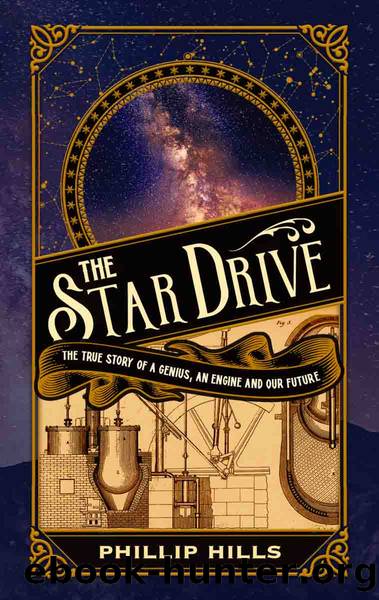The Star Drive by Hills Phillip;

Author:Hills, Phillip;
Language: eng
Format: epub
Publisher: Birlinn
Variations on the Stirling engine were quite astonishing: literally dozens of different versions were made for as many different purposes. The Rider-engined pumps were used on railways to supply well water for steam locomotive engines: steam locos were very thirsty beasts indeed and they must be supplied with reasonably clean water. Farms used the engines to provide water for animals and for irrigation; towns used them to pump domestic water from distant wells and to supply tanks in tall buildings, as well as to circulate central heating. The engines were widely used in industry: especially in the thousands of workshops too small to justify the installation of a steam engine. There they drove saws, lathes, drills and milling machines, as well as cranes, planers and machine hammers. The engine could be supplied small enough to drive an individual machine or large enough to drive an overhead shaft from which drive could be taken by countershafts to particular applications, as was common practice in larger, steam-driven workshops.
The later nineteenth century suffered from what we would today call an information revolution. Literacy was widespread for the first time, there was huge demand for printed paper and consequently for printing presses. The Stirling-type engine was perfectly suited to the latter: it could be provided in just the right size, the office boy could light its fire first thing in the morning and need tend it only a few times during the working day. The engine was in demand for churches: where previously the organ had depended for its air on a boy doing the pumping (from the 1890s he need only get up in time to light the fire). It could supply secular music too, for the air engine was used to drive player pianos and even gramophones. (There are advertisements offering all these things and more, with graphics.)
To continue the list would be tedious, but there are a few applications of the engine which really have to be mentioned, if only because they seem now to be bizarre. It was used to drive dentistsâ drills â presumably as an alternative to the usual foot-pedal; there is an advert for a room fountain for a large house or hotel, in which a water jet emerges from a bunch of flowers, having been pumped by a Stirling engine beneath; there are rotating shop window displays; there are model boats and tramcars. The engine was even used to provide lighting: by driving a dynamo for electricity and by giving gaslight by blowing air over petroleum to produce an inflammable gas. (The latter must have smelt disgusting and been a safety nightmare: the Stirling engine which pumped the air was fuelled by an open gas flame from the same source. Starting it must have been interesting.)
Possibly the most improbable use for the engine may have been to drive a fan. The idea of using a heat engine running on a burner to cool the air seems odd, but they were very popular and several different firms offered them.
Download
This site does not store any files on its server. We only index and link to content provided by other sites. Please contact the content providers to delete copyright contents if any and email us, we'll remove relevant links or contents immediately.
The Complete Stick Figure Physics Tutorials by Allen Sarah(7135)
Secrets of Antigravity Propulsion: Tesla, UFOs, and Classified Aerospace Technology by Ph.D. Paul A. Laviolette(4974)
Thing Explainer by Randall Munroe(3782)
The River of Consciousness by Oliver Sacks(3414)
The Order of Time by Carlo Rovelli(3072)
How To by Randall Munroe(2911)
I Live in the Future & Here's How It Works by Nick Bilton(2840)
A Brief History of Time by Stephen Hawking(2819)
What If?: Serious Scientific Answers to Absurd Hypothetical Questions by Randall Munroe(2542)
The Great Unknown by Marcus du Sautoy(2533)
Midnight in Chernobyl by Adam Higginbotham(2386)
Blockchain: Ultimate Step By Step Guide To Understanding Blockchain Technology, Bitcoin Creation, and the future of Money (Novice to Expert) by Keizer Söze(2379)
Networks: An Introduction by Newman Mark(2264)
The Meaning of it All by Richard Feynman(2213)
Easy Electronics by Charles Platt(2205)
The Tao of Physics by Fritjof Capra(2164)
Midnight in Chernobyl: The Untold Story of the World's Greatest Nuclear Disaster by Adam Higginbotham(2075)
When by Daniel H Pink(2020)
Introducing Relativity by Bruce Bassett(2018)
